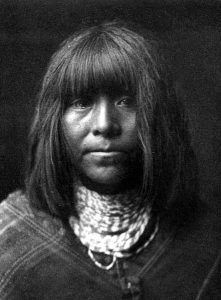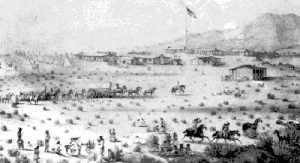
Ta’thamiche, a Hualapai Indian by Edward Curtis, 1907
The Hualapai War was an armed conflict that began in 1865 between the Hualapai and the U.S. Army and lasted until 1870.
The tribe lived in the area between the Grand Canyon and the Bill Williams River. In 1857 Edward Beale carved a wagon road from Fort Defiance to the Colorado River on the border between Arizona and California. The path cuts right through Hualapai territory. In 1863, gold was discovered in the Prescott Valley, and the gold rush brought a steady flow of miners and other settlers to the area. The following year, a toll road was built through Hualapai territory between Prescott and Bull Head City. Like other tribes, the Hualapai were disturbed by increased settler traffic upon their lands. Still, relations between them and the new settlers were generally peaceful until April 1865, when a drunken settler killed one of their leaders named Anasa.
In retaliation for the murder, the Hualapai cut off the Fort Mojave-Prescott Toll Road to the Colorado River ports and raided anyone trying to get through. However, Captain W.H. Hardy soon negotiated a peace agreement at Beale Springs, and the raids and the fighting stopped. But it didn’t last. Nine months later, another leader, Chief Wauba Yuma, was murdered over a treaty dispute, and the raids began again in full force.
In response, the Fort Mojave Cavalry was sent out, which resulted in the cavalry burning villages and several battles. The war lasted until December 1868, as the Hualapai began to surrender as whooping cough and dysentery were weakening their ranks. Though the vast majority surrendered, one warrior named Sherum continued the battle for another two years. The violence finally ceased in 1870. During these years, it is estimated that one-third of the Hualapai people were killed either by the conflict or disease.
Afterward, many of the Hualapai were moved to a reservation at Camp Beale’s Spring but moved to the Colorado River Reservation near La Paz three years later. Some went to a temporary reservation at Camp Date Creek, but by 1874 the post was closed. Conditions at the reservations led to starvation and disease. Hence, in 1875 some of the Hualapai escaped to their traditional lands, only to find that others had already settled it. It is estimated that one-third of the Hualapai population was lost between 1865 and 1870.
In 1883, a 900,000-acre reservation was established for the Hualapai. Its headquarters are located in Peach Springs, Arizona.
© Kathy Weiser-Alexander/Legends of America, updated November 2021.
Also See:

